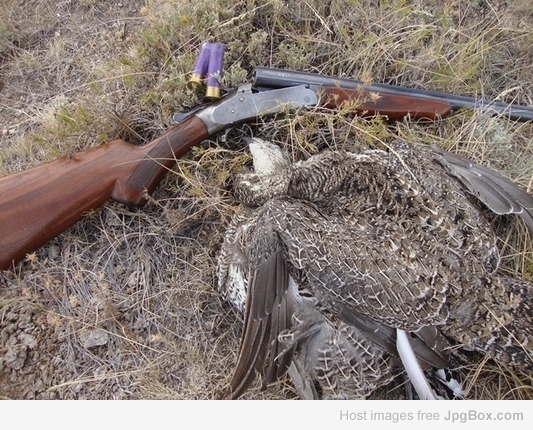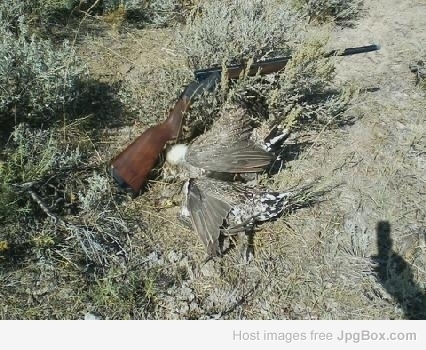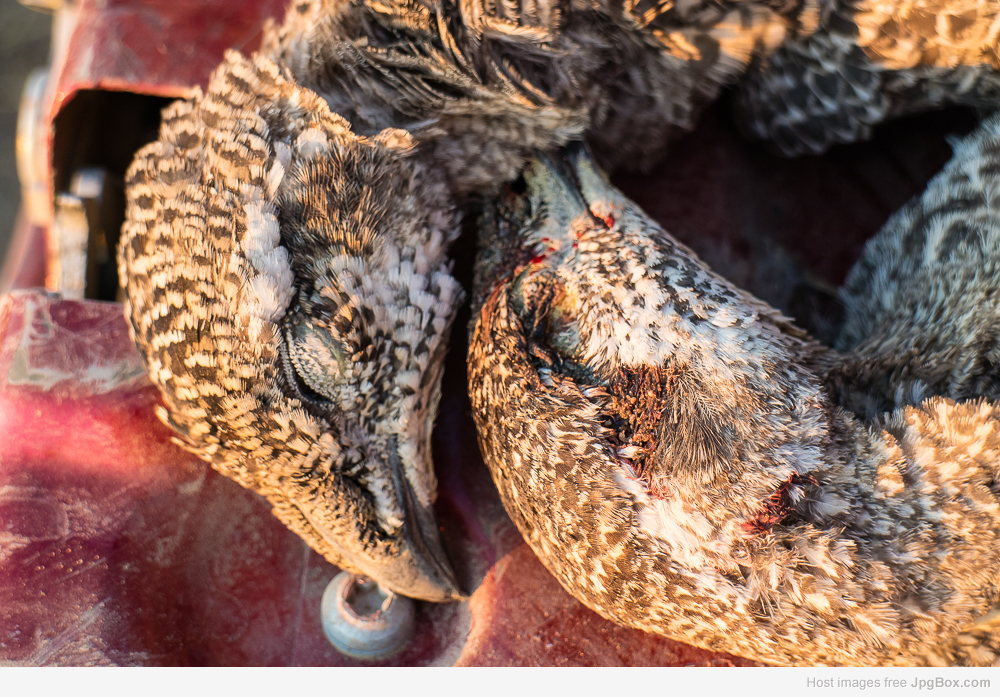| Author |
Message |
| < 16ga. General Discussion ~ Meat eater |
|
 Posted:
Sat Apr 04, 2020 3:59 pm Posted:
Sat Apr 04, 2020 3:59 pm
|

|
|
Member

Joined: 18 Aug 2010
Posts: 399
Location: Ballymoney Northern Ireland
|
|
| Just watched Meat eater on Netflix tonight, hunting Sage Grouse in Wyoming , this is a good show , looks like it would be fun , anyone on here hunt there and have any stories you would like to share , I know I would like to hear your experiences, keep safe all WJ. |
|
|
|
|
|
 |
|
 Posted:
Sat Apr 04, 2020 6:07 pm Posted:
Sat Apr 04, 2020 6:07 pm
|

|
|
Joined: 28 Mar 2008
Posts: 1460
Location: Eagle, Nebraska
|
|
Have hunted sage grouse, have a fan on my wall. Wanted to mount the whole bird, was a big bomber, but he was too boogered up and she couldn't do it.
The young ones are good eating, old ones not so much |
|
|
|
|
|
 |
|
 Posted:
Sat Apr 04, 2020 7:01 pm Posted:
Sat Apr 04, 2020 7:01 pm
|

|
|
Joined: 26 Sep 2015
Posts: 94
Location: Fremont County, Wyoming
|
|
Grew up hunting sage "chickens." Was my first hunting experience at 12 years old, and the limit was 4 birds. You had to be 14 to hunt big game in the state back then (mid .1970's). Hunted them every year until the late 80's when I moved to Nevada for 5 years. Killed a few birds out there. Moved back ti Wyoming in '94, but concentrated on big game and didn't hunt with a shotgun for many years until about 2014. Since then I've killed a limit of 2 birds each year. Most of the time lately, I've used a single shot 12 or 20, but last year I used my 16 gauge Iver Johnson I inherited from my dad. When I figure out how, I'll post some pictures.
Let's see if I can post pics now:
 [/URL]
[/URL]
and another
 [/URL]
[/URL] |
Last edited by gomerdog on Thu Apr 16, 2020 5:58 pm; edited 2 times in total |
|
|
|
|
 |
|
 Posted:
Tue Apr 07, 2020 5:53 pm Posted:
Tue Apr 07, 2020 5:53 pm
|

|
|
Joined: 17 Jan 2014
Posts: 1377
Location: Denver, Colorado
|
|
| MeatEater is pretty good. His books aren't bad either. Sage grouse are pretty unique. The biggest of the North American grouse. Been awhile since I've killed any. The smaller birds-of-year eat ok. The big bombers can be a bit tough (I lived and worked in Rock Springs, WY back in the early 80s). I've hunted them since, out where I hunt elk near Maybelle, Colorado. Like everything else it seems, the numbers are way down anymore, so I mostly leave them alone these days. |
_________________
'Tis better to burn out than it is to rust...... |
|
|
|
|
 |
|
 Posted:
Wed Apr 08, 2020 7:39 am Posted:
Wed Apr 08, 2020 7:39 am
|

|
|
Member

Joined: 27 Jun 2012
Posts: 1113
|
|
The first sage grouse my GSP, Bode pointed while hunting the Pinedale, WY area was a little perplexing on the retrieve. Bode is a fanatical retriever who flies to the bird and grabs it up, but then returns reluctantly because he wants to keep the bird. I sometimes have to hurry him along on the return. This sage grouse flushed high when I went in and a load of #6's dropped him about 25 yards away. Bode was on it in a flash, but seemed to have trouble picking it up. I started calling for him to "fetch it" as he made several abortive attempts at picking up the big bird. My Alabama hunting buddies swear Bode would retrieve a Volkswagen if I shot it, so this was strange behavior. Finally, he had the bird and came in. As he approached, I finally figured out what was wrong. The sage grouse was just covered with cockle burrs and Bode's ears were stuck to the side of his head and his mouth and lips were just covered with those nasty things. After a lot of praise and more than a few pricks removing the burrs from my buddy, the hunting resumed.


Bode and a limit of sage grouse |
_________________
An elderly gentleman, his faithful dogs, and a 16 ga SXS. All is right with the world. |
|
|
|
|
 |
|
 Posted:
Wed Apr 08, 2020 8:58 am Posted:
Wed Apr 08, 2020 8:58 am
|

|
|
Member

Joined: 18 Aug 2010
Posts: 399
Location: Ballymoney Northern Ireland
|
|
Thanks for the responses guys , brilliant photos Riflemeister great to hear your experiences and stories,
Keep safe WJ. |
|
|
|
|
|
 |
|
 Posted:
Wed Apr 08, 2020 2:11 pm Posted:
Wed Apr 08, 2020 2:11 pm
|

|
|
Member

Joined: 15 Apr 2007
Posts: 9463
Location: Amarillo, Texas
|
|
Riflemeister.
Bode is ONE smart dog, even I know to stay away from the nasty cockle burrs 
Again THANK YOU for all you have done.
Love the license plate
Mike |
_________________
 ,
,

USAF RET 1971-95 |
|
|
|
|
 |
|
 Posted:
Mon Apr 13, 2020 7:20 am Posted:
Mon Apr 13, 2020 7:20 am
|

|
|
Joined: 15 Dec 2011
Posts: 156
|
|
| Beautiful bird, but on a near threatened status. Let 'em be. |
_________________
Thats right, I'm an armed liberal (SORT OF) and I like to shoot furry little critters.... and I kill 'em with:
12Ga LC Smith
16Ga Fox Sterlingworth
16Ga BRNO
20Ga LC Smith
20Ga Miroku x2 (Model F & Model 500)
28Ga AYA 4/53 (bucket list item #6) |
|
|
|
|
 |
|
 Posted:
Mon Apr 13, 2020 8:16 am Posted:
Mon Apr 13, 2020 8:16 am
|

|
|
Joined: 26 Sep 2015
Posts: 94
Location: Fremont County, Wyoming
|
|
| Hunting has virtually no effect on sage grouse populations. Weather and human disturbances are the bane of these birds. |
|
|
|
|
|
 |
|
 Posted:
Mon Apr 13, 2020 5:05 pm Posted:
Mon Apr 13, 2020 5:05 pm
|

|
|
Joined: 16 Jul 2015
Posts: 2125
Location: Hudson,Wy
|
|
My thoughts on sage grouse. Sage grouse are the bird that started my hunting career in the late 1980's. A couple of friends finally convinced me to put down the fishing rod long enough to try hunting. The final weekend of season found me begging the keys to my Dad's truck and $20 worth of gas money to go try a spot with one of these friends. My folks were mighty strapped for cash but Dad knew a good cause when he saw one.
Come Saturday, Fred and I went to "the spot". We had little knowledge of what we were doing and my contribution to that knowledge was nil. Not a bird did we sight. Droppings and tracks told the story of two young boys in need of a dog that could sniff out birds that we couldn't. The next day we took our final pilgrimage to the sage, for season ended at dark. Eventually we lucked out and found birds. Lots of birds. The world was a blur for the next 10 minutes as we flushed and shot at sage grouse. We even hit some of them. That first limit of grouse started in motion a chain of events that made me into who I am. I still hunt them as often as I can. Like gomerdog points out, hunting has no effect on the population.
That said, lets get into this whole misunderstanding about sage grouse and their current status. A lot of blame has been haphazardly flung about, and most of it is irresponsible speculation in a an attempt to find answers that for the most part have been there all along. I say this in part due to my extensive observations living right in the midst of this magnificent bird.
Much of the country I hunt/ watch them in is what scientists refer to as "control group" habitat, meaning that the countryside is almost entirely unchanged during the past 100 years. I say mostly for a reason and therein lies the crux of the matter. Three things have changed. The most important is the gradual aging of the sage lands. It happens so slowly that unless you have remained intimately familiar with exact locations for decades, it is imperceptible.
The early years of my bird hunting career were largely spent hunting the same mountainside a few miles from my parent's home. At the time it was due to a near total lack of gas money. Today I still hunt there, because I love the place. Many species of game bird are found there, some in modest numbers if the year is kind. However, sage grouse have steadily declined as the the average age/ height of sage brush has increased. It has been directly proportional. I have watched this in other areas as well. Habitat that has aged slower due to soil quality, elevation, and water conditions is still harboring the same number of birds, with year to year variations based on weather patterns and grasshopper abundance.
I will add that sage grouse may dust and take cover in mid to old growth sage, but they don't seem to be eating it. During feeding times, early and late in the day, I seldom find them feeding in sage much higher than my ankle (there's a hunting tip in case anyone's paying extra attention). The place near my parent's house, which has shown me the greatest decline in sage grouse, has lost almost all of this low height sage.
The second thing that has changed is our livestock grazing practices. Note that I say practices. Grazing has always been present, but how it occurs has changed drastically. The currently popular method is often termed "take 50/ leave 50". Land is annually grazed down, but only partially. Now this sounds benevolent in theory, but in reality it is not how the ecosystem was historically maintained. Before the days of livestock, great herds of bison roamed the region, heavily grazing an area before moving on. This perpetuated a cycle of intensive consumption and fertilization followed by a lengthy period of regeneration of growth, often a 3-5 year cycle. The current practice does not allow this. One fairly wise individual I know is in a position now to try changing this to the benefit of livestock growers and wildlife both. This concept applies to all prairie life and I have seen it at work in Nebraska with prairie chickens and sharptail grouse. If you know the grazing rotation, you can very accurately predict where the birds are come hunting season.
The third change, one seldom considered, is the presence of highways and power lines. These have supported an increase in Corvids, ravens and magpies specifically. The highways provide plenty of roadkill to feed more of these resourceful creatures. Power lines and fences provide convenient places to rest and watch. These birds are notorious nest predators. Game and fish personal across the sage grouse states have observed and recorded a disturbing amount of egg destruction. Nevada for one, has begun using eggs poisoned with a corvicide to combat issue.
That's the short version of it and it may not match the sensationalized rhetoric of people unfairly using sage grouse as a tool to accomplish an agenda, but that's just the way it really is. I'm looking at the long term trends and not short term trends that just happened to coincide with a series of droughts. These are the only valid factors that I have found that mirror long term population trends and there is evidence to support it. A lot of things that people have tried to link to the decline have either been present far too long in advance of declines, have not been present long enough, or coincided with a drought and then suddenly became irrelevant with the return of normal to wet weather patterns.
In the end, in largely unchanged areas I have been finding roughly the same number of grouse as I always have, in accordance with moisture and grasshopper conditions. In other words, area "A" has always held the same numbers during each drought as it did during previous droughts and during wet years, similar highs. I continue to hunt based on my preseason findings, as I always have. It's a terribly short season for a bird we hold near and dear to our hearts. It would be a shame to let that go based on popular opinion.
[[URL=https://www.jpgbox.com/page/55005_1000x667/]
 [/URL]][/img]
[/URL]][/img] |
_________________
Only catch snowflakes on your tongue AFTER the birds fly south for the winter... |
|
|
|
|
 |
|
 Posted:
Tue Apr 14, 2020 8:26 am Posted:
Tue Apr 14, 2020 8:26 am
|

|
|
Member

Joined: 27 Jun 2012
Posts: 1113
|
|
| Another issue I ran into was the loss of habitat due to oil and gas wells that seemed to proliferate during my years of sage grouse hunting. The early season and higher altitude sage brush country of southwest Wyoming was a perfect opportunity to get the dogs and myself in shape for bird season, plus it was just a heck of a lot of fun going after those big bombers. Early on, I had great success east of the Green River near Big Piney. Not long into my sage grouse hunting, there was a big uptick in oil and gas wells and all the attendant vehicle traffic and the hunting in that area just collapsed. A few more years of trying to find consistent sage grouse numbers and I moved my early hunting to northern Montana. I ran into the same oil and gas well issue hunting antelope and mule deer north of Glenrock, WY . That and getting more involved in bird dogs and bird hunting basically saw an end to my rifle hunting in that area. |
_________________
An elderly gentleman, his faithful dogs, and a 16 ga SXS. All is right with the world. |
|
|
|
|
 |
|
 Posted:
Tue Apr 14, 2020 9:18 am Posted:
Tue Apr 14, 2020 9:18 am
|

|
|
|
|
| Riflemeister wrote: |
|
Another issue I ran into was the loss of habitat due to oil and gas wells that seemed to proliferate during my years of sage grouse hunting. The early season and higher altitude sage brush country of southwest Wyoming was a perfect opportunity to get the dogs and myself in shape for bird season, plus it was just a heck of a lot of fun going after those big bombers. Early on, I had great success east of the Green River near Big Piney. Not long into my sage grouse hunting, there was a big uptick in oil and gas wells and all the attendant vehicle traffic and the hunting in that area just collapsed. A few more years of trying to find consistent sage grouse numbers and I moved my early hunting to northern Montana. I ran into the same oil and gas well issue hunting antelope and mule deer north of Glenrock, WY . That and getting more involved in bird dogs and bird hunting basically saw an end to my rifle hunting in that area.
|
We have a niece ranching near Daniels, and I have had beers at the Green River Bar. Beautiful part of the world. |
|
|
|
|
|
 |
|
 Posted:
Tue Apr 14, 2020 9:42 am Posted:
Tue Apr 14, 2020 9:42 am
|

|
|
Joined: 16 Jul 2015
Posts: 2125
Location: Hudson,Wy
|
|
| I have received recent reports of a sage grouse rebound between Pinedale and Big Piney over the past few years. For what it's worth, the undisturbed areas I hunt showed a temporary decline during the exact same period. Remember, we had some serious problems credited to West Nile Virus at that time. |
_________________
Only catch snowflakes on your tongue AFTER the birds fly south for the winter... |
|
|
|
|
 |
|
 Posted:
Tue Apr 14, 2020 12:35 pm Posted:
Tue Apr 14, 2020 12:35 pm
|

|
|
Joined: 26 Sep 2015
Posts: 94
Location: Fremont County, Wyoming
|
|
| Hope these recent snow storms and the storms coming up later this week don't wreck havoc with their nesting success. |
|
|
|
|
|
 |
|
 Posted:
Tue Apr 14, 2020 5:35 pm Posted:
Tue Apr 14, 2020 5:35 pm
|

|
|
Joined: 16 Jul 2015
Posts: 2125
Location: Hudson,Wy
|
|
| It shouldn't have. I would be worried about later storms that typically arrive in May. Most of the hens that breed recently are still traveling off to where they will nest and building nests right now. They will lay two eggs every 3 days for about 9 days. The incubation period is 25-27 days. Cold wet weather from the end of May thru early June, during the hatch, is the biggest weather factor. Drought following the hatch can also be devastating due to lack of insects chick must have to survive. |
_________________
Only catch snowflakes on your tongue AFTER the birds fly south for the winter... |
|
|
|
|
 |
|